|
|
|
Air Force Units
77th |
| |
|
|
 |
Air Corps Interception Control Squadron/Fighter Control Squadron
Activated: 7 February 1942, Baer Field, Indiana as 78th Air Corps Interception Control Squadron
Relocated: April 1942, California
Redesignated: May 1942, 78th Fighter Control Squadron
Relocated: October 1942, Portland, Oregon
Relocated: December 1942, Fort Dix, New Jersey
Arrived: 3 February 1943, Oran Algeria
Note: Originally a truck company from Portland, Oregon
Subordinate to: 12th Air Force, 63rd Fighter Wing
Relocated: March 1943, Monastery between Oran and Oujda, Algeria
Relocated: May 1943, Maison Blanc, Algeria
Note: At this time the unit was split into two units, the 78th and the other is unknown at this time, but was commanded by Capt. Tarleton Redden.
Relocated: November 1943, Alghero Airdrome, Sardinia
Relocated: Pisa, Italy
Relocated: Coltano, Italy
Relocated: Bologna, Italy
Commander:
5 February 1943 - (?), Captain Stuart O. Van Slyke (later Major)
Note: an un-official unit insignia was described as being a "shield inclosing a cross" signifying that the squadron was situated at a monastery.
Note: Participated in Rome-Arno Campaign
Reactivated: 21 September 1944, Pisa, Italy
Mission: 1945, Installation and maintenance of Forward Fighter Control Operations, defensive and offensive, for purposes of coordination in air-ground operations.
Awards and Decorations:
Commended for Actions in Algiers Sector, Algeria before the invasion of Sicily
Squadron Direction Finding stations (and ?)
Fixer 1 - Private Aaron Nienhaus chief. Near a lighthouse
Fixer 2
Fixer 3
Fixer 4
Fixer 5
Station 56 - Unknown mission
|
|
| |
Fighter Control Squadron
Relocated: From Selfridge Field, Michigan to Fighter Command School, Orlando, Florida
Inactivated: 20 November 1942
|
|
|
Tactical Control Flight
FACP (Forward Air Control Post)
Cannon AFB, New Mexico, 1977 - 1981
Subordinate to: 602nd TCG, Bergstrom AFB, Texas
Relocated: Kadena AB Okinawa, Japan (1981)
Note: The 81st TCF (Tactical Control Flight) was transferred to PACAF for ground radar business at Kadena Air Base, Okinawa, Japan.
Subordinate to: 623rd TCS, 5th TACAIR in Osan, Korea
Deployments: Red Flag (Nevada) 1979; Augmented 82nd TCF to Saudi-Arabia 1980; Holloman AFB, New Mexico 1980; Team Spirit 1981 Korea; Team Spirit 1982 (on Young Mountain about 35 miles from Osan, Korea);
Misawa, Japan (Spring 1982); Kunsan, Korea (Fall 1982)
Commander: Major Lawrence (Larry) Davis
Equipment: TPS-44 (1977), 2 each TPS-43E (Late 1978)
Notes: (1)81st is the only squadron in the Air Force to own and maintain two AN/TPS-43E radars, one for training and daily operations and one for mobility. (2) The 81st replaced the 609th at Cannon AFB, when the 609th transferred to Germany in the mid-70's. (3) Deployed to Holloman AFB, New Mexico when the 82nd deployed to Saudi Arabia in October 1980.
Roster
Convoy Memories |
|
Tactical Control Squadron
|
|
Air Control Squadron
Kadena, Japan
|
|
| |
Interceptor Control Squadron/Fighter Control Squadron
Activated: 9 February 1942, Harding Field, Baton Rouge, Louisiana
Redesignated: May 1942, Fighter Control Squadron
Located: California from April 1942, to January 1943
Relocated: February 1943, Algeria
Relocated: March 1943, Tunisia
Relocated: July 1943, Sicily
Relocated: September 1943, Italian mainland
Note: Participated in Tunisian, Sicilian and Italian Campaigns between March and September 1943
Relocated: 26 January 1944, From Naples to Anzio Beachhead
Mission: Maintain forward fighter control operations, defensive and offensive
Located: (date unknown) Orbetello, Italy
Note: (date unknown) Part of Squadron also at Piombino, Italy
Note: Participated in captured of Island of Elba
Relocated: Moved to France. Participated in Allied Campaign in Southern France
Relocated: October 1944, St. Tropez, France
Note: 1944, Stationed at St. Tropez, Dole, Ludres, Xertigny and Rougemont, France
Mission: Maintain Forward Fighter Control operations, both defensive and offensive. Conduct air and sea rescue and convoy patrol operations
Note: Participated in Battle of Pantelleria (Island in the Mediterranean Sea between Sicily and Tunisia, and in the Battle of Salerno, Italy
Note: Supported the French Army from the Riviera to the Rhine river.
Relocated: (April 1945) Germany
Relocated: Edenkoben, Germany
Relocated: Schwabisch-Hall, Germany
Relocated: Markheidenfield, Germany
Inactivated: 10 October 1945
|
|
Tactical Control Flight
Subordinate to: 726th Tactical Control Squadron, Holliman AFB, New Mexico
Located: July 1969 McConnel AFB, Wichita Kansas
George AFB, California (1970's)
Call Sign: China Rose
Subordinate to: 607th TCS
Relocated: Holloman AFM, New Mexico
(1980)
Deployed: Al Jubail, Saudi Arabia, 2 October 1980 (First unit in "Elf Exercises")
Deployed: 1 August - 8 November 1985, Senior Knight
Commanders:
1969, Captain Fleming-Jones
1974-1976 James Bridges (Lt Col. Ret.)
1976- 19XX Major Wade
? - ? Major Bob Pike
Equipment:
Radar:
TPS-44D; TPS-43E
Radio:
1-TSC-53 comm
1-TRC-97
Other:
14 - M35A2
1 - M37
2 M151a1
Notes: The story was that this was a call sign (China Rose) from Korea and we fought hard to keep it. Our streamers indicated we had been there during the Korean War.
Roster
Exercises:
1985
Poker Buff
1986
Aim high 86-1
Desert Airman |
| |
|
Tactical Control Flight
Located: Davis-Monthan AFB, AZ/
Relocated: 1984, moved to Holloman AFB, New Mexico to collocate with sister flight.
Subordinate to: 607th TCS
Commanders:
November 1980 Major Bowman
1981 - 1983 Major "Skosh" Baconi
1983 - (?) Major David Strick
(?) - (?) Major Bruce F. Queen
1st Sergeants:
MSgt McNamara
MSgt Thomas 'Slick' Seidel
Deployments:
April - May 1983, Saudi Arabia (personnel only)
Fall 1983, Central America (3 months)
Equipment: AN/TPS-43E
|
|
| |
Tactical Control Flight
Located: Hill Air Force Base, Utah
Activated: 1 October 1985, to operate one of two AN/TPS-43E radars at Hill Air Force Base |
|
Radar Evaluation Squadron
Hill AFB, Utah |
|
|
Fighter Wing
Biak Island Operation
Organizations attached:
Company B, 583rd Signal Air Warning Battalion
Company A, 565th Signal Air Warning Battalion
Plotting Platoon, E(?), 583rd Signal Air Warning Battalion,
(Attached Company A, 565th Signal Air Warning Battalion)
1st Platoon, Company A, 574th Signal Air Warning Battalion, (Attached Company A, 565th Signal Air Warning Battalion)
1st Platoon, 724th Signal Air Warning Company, (Attached Company A, 565th Signal Air Warning Battalion)
Leyte Gulf Operation
Notes: 26th September 1944, 6th Army will place under the operational control of the 85th Fighter Wing two (2) SCR-584's radar platoon (RS 880 and RS 881), and two (2) SCR-682's radar platoons (RS 860 and RS 861).
Notes: The aircraft warning units of the XXIV Corps from the Central Pacific Theater have been placed under the operational control of the 85th Fighter Wing for the Leyte Island operation. The GO, XXIV AW Units will be responsible to the CO, 85th Fighter Wing for installation and operation of the XXIV Corps AW units. Operating procedure will be in accordance with SOP V FC. They will be used in conjunction with the radar units of the 85th Fighter Wing to provide aircraft warning in the 40th Fighter Sector. The Leyte Fighter Control Center will employ four (4) SCR-270's and four (4) SCR 527's from the XXIV Corps. The four (4) SCR-270 units are hereby designated as RS 870, RS 871, RS 872 and RS 873. The four (4) SCR-527's are hereby designated as RS 850, RS 851, RS 852 and RS 853.
Organizations attached:
Company C, 583rd SAW Battalion with attached G.O. Platoons of Company D.
Comp nay C, 574th SAW Battalion
8th Radar Calibration Detachment
Plan for the Development of Aircraft Warning and Control, Leyte invasion.
|
|
Tactical Control Flight
Luke AFB, Glendale, Arizona
ASRT
|
|
|
Fighter Wing
Headquarters
Activated: 1 December 1943, March Field, California
Mission: Preparations for overseas movement
Relocated: 25 March 1944, Camp Stoneman, Pittsburgh, California, for deployment
Departed: 28 March 1944
Arrived: 1 May 1944, Finschhaven, New Guinea
Mission: Defense of 21st and 23rd Fighter Sectors; Finschhaven and Cape Gloucester area.
Relocated: 4 May 1944, south of Finschhaven Air Strip
Departed: 28 July 1944
Arrived: 1 August 1944, Toem, Dutch New Guinea
Mission: Staging for forward move.
Departed:16 August 1944
Arrived: 19 August 1944, Sansapor
Mission: Defense of 34th, 35th and 36th Fighter Sectors; from Noemfoor to Morotai.
Departed: 28 December 1944
Arrived: 13 January 1945, Lingayan, Luzon
Mission: Defense of 45th and 56th Fighter Sectors; American occupied Luzon.
Assigned Units:
33rd Fighter Control Squadron
36th Fighter Control Squadron
56th Fighter Control Squadron
565th Signal Air Warning Battalion
595th Signal Air Warning Battalion
596th Signal Air Warning Battalion
10th Radar Calibration Detachment
Detachment "G" 86th Fighter Wing
Detachment "H" 85th Fighter Wing
Detachment "I" 86th Fighter Wing
Commanders:
11 December 1943 - 14 December 1943, Lt. Col. Robert L. Johnston
14 December 1943 - 16 September 1944, Col. Romulus W. Puryear
16 September 1944 - 5 November 1944, Col. Robert L. Johnston
5 November 1944 - 14 December 1944, Col. Norman D. Sillin
14 December - (?), Col. James O. Guthrie
Detachment G (Fighter Control Center) (Special)
Headquarters
Activated: 16 November 1943, Paine Field, Everett, Washington
Relocated: 9 January 1944, Camp Stoneman, for deployment
Departed: 10 February
1944
Arrived: 9 March 1944, Milne Bay, New Guinea
Relocated: 20 March 1944, Nadzab
Relocated: 11 - 12 April 1944, Goodenough Island
Notes: Transported by C-47. Set up camp next to Company D, 583rd Signal AW Bn.
Departed: 18 April 1944
Arrived: 23 April 1944, Hollandia
Mission: "To provide Fighter Control facilities and to establish and Air Warning System. Original plan of action called for the establishment of the 31st Fighter Sub-sector at Tanahmerah Bay and the setting up of "Shadow" Relay Station at Humboldt Bay."
Relocated: 28 April 1944, Pim. Set up operations on Leimok Hill above Pim jetty.
Relocated: 5 May 1944, Hollandia Drome
Relieved of duties: 28 May 1944, by 49th Fighter Control Squadron.
Reorganized: 7 June 1944; no change in personnel, but slight changes in authorized equipment.
Departed: 27 June 1944, Hollandia
Staged: Toem
Departed: 30 June 1944, Toem, Dutch New Guinea
Arrived: 2 July 1944, Noemfoor Island
Mission: "Provide for the establishment of the 34th Fighter Control Sector at Noemfoor with all the necessary facilities for adequate Air Warning and fighter Control of the area."
Note: Set up just to the west of the Kamiri strip.
Note: 3 July 1944, 34th Fighter Control Center (Temporary) operational.
Note: The remainder of the month after 22 July was spent supervising the development of permanent Air Warning and Fighter Control installations on the Island.
Relieved of duties: 31 August 1944
Departed: 6 November 1944, Noemfoor Island
Arrived: 9 November 1944, Toem, Dutch New Guinea, staging for Lingayen, Philippine Island invasion
Note: Set up adjacent to Company "C", 596th Signal AW Battalion.
Departed: 26 December 1944, Toem, Dutch New Guinea
Note: Included the Assault Echelon of Det "B", 35th Fighter Control Squadron and the Assault Echelon of Company "C", 596th Signal AW Battalion.
Mission: "To supervise the installation and operation of an Air Warning System with Fighter Control facilities."
Landed: 10 January 1945, Lingayon (White Beach)
Relocated: 12 January 1945, From Lingayen market place to Caloocan schoolhouse.
Relieved of duty: 23 January 1945, by 45th Fighter Control Center.
Note: "From 12 January 1945 to 24 January 1945 the Detachment worked at the establishment and operation of adequate Air Warning and Fighter Control facilities. As the Ground Forces advanced radar stations and ground observer posts were moved to give air warning coverage over a wider area. The area was much larger than any previous invasion the Detachment had been on and various new problems arose to be solved."
Located: May 1945, Laoag, covering the Cagayen Valley.
Equipment: Three (3) AN/TPS-2 radars
Relieved of operational control: 29 May 1945
Commanders:
16 November 1943 - 30 September 1944, Lt. Col. John H. Spangler
Note: Lt. Col. Spangler was seriously injured in an airplane crash while returning from Wing Headquarters on 30 September 1944.
12 November 1944 - 28 November 1944, Maj. Joseph C. Tuell
28 November 1944 - (?), Maj. Franklin L. Doughty
Awarded: Letter of Appreciation, 26 January 1945. "For the complete and willing support which they have given in the past three years."
Detachment H
Activated: 16 November 1943, Paine Field, Everett, Washington
Relocated: 9 January 1944, Camp Stoneman, for deployment
Detachment I
Activated: 16 November 1943, Paine Field, Everett, Washington
|
| |
| |
Fighter Control Squadron
Activated: 15 March 1943, Dow Field, Bangor, Maine
Mission: To provide controlled interception, homing, and air to ground communications by means of VHF radio equipment
Relocated: August 1943, Fort Dix Army Air Base, New Jersey
Note: Operated stations in District of Columbia, Maryland, Pennsylvania, and New Jersey
Disbanded: 10 April 1944, remaining personnel became nucleus of 161st Army AIr Force Base Unit (Fighter Control)
|
|
| |
Fighter Control Squadron
Activated: 25 March 1943, Otis Field, Massachusetts
Relocated: May 1943, Boston, Massachusetts
Note: Took over control center and radio stations of the Boston Fighter Wing
Mission: To man and operate both fixed and mobile radio stations for the control of fighter planes in the area allocated to the Boston Fighter Wing, both for the defense of that area and for the training of radio communications teams and fighter pilots, and in the radio control of fighters.
Note: Operated nine stations in eastern Massachusetts, as well as stations in neighboring New England states.
Relocated: 1 September 1943, Bedford Army Air Base, Bedford, Massachusetts
Inactivated: 10 April 1944
|
|
| |
Fighter Control Squadron
Activated: 1 April 1943, Westover Field, Massachusetts
Mission: Defense of Eastern coast of the United States around the harbor of New York City, New York
|
|
| |
Fighter Control Squadron
Activated: 20 March 1943, Bradley, Field, Connecticut
Mission: To defend Northeast coast by controlling and directing friendly fighter aircraft toward incoming enemy flights, to function offensively by directing fighters in Tactical support of allied strategy, and to operate homing stations to rescue lost pilots.
Mission: Changed to supervision of the activation and training of satellite squadrons.
Note: Operated school for technical and operational training
Inactivated: 7 April 1944
Reactivated: 1 October 1944, Bradley Field, Connecticut
Relocated: March - April 1945, via Camp Kilmer New Jersey, to France
Relocated: April 1945, Namur, Belgium
Note: Radio stations operated at Malmedy, Belgium, and Eberbach, Trier and Winnweiler, Germany
|
| |
| |
Fighter Interceptor Control Squadron/ Fighter Control Squadron
Activated: 1 April 1943, Fort Niagara, New York
Relocated: July 1943, Connecticut
Relocated: December 1943, Westhampton Beach, New York
Inactivated: 10 April 1944
Reactivated: 1 October 1944, Bradley Field, Connecticut
Relocated: Camp Pinedale, Fresno, California
Note: Stationed Camp Pinedale for training. (See A0833)
Relocated: September 1945, The Hawaiian Islands
|
|
| |
Fighter Control Squadron
Activated: 1 April 1943, Mitchel Field, New York
Inactivated: 11 October 1945
|
|
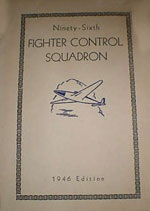 |
Fighter Control Squadron
Activated: 15 May 1943, Bradley, Field, Connecticut
Located: 1945, Dudkhundi, India
Mission: 1945, Provided communications and air warning in case of attacks by enemy
Note: Still in existence in 1946
|
|
| |
Fighter Control Squadron
Activated: 15 May 1943, Sarasota, Florida
Mission: Controlling fighter aircraft in the interception of enemy aircraft.
Disbanded: 27 April 1944, De Ridder Army Air Base Louisiana
|
|
| |
Fighter Control Squadron
Subordinate to: Seattle Control Group (Provisional)
|
101st (Air National Guard) |
|
Air Control Squadron
Allotted: 24 May 1946 to Commonwealth of Massachusetts ANG
Organized: (Authorized) October 1946
Organized: January 1947, granted federal recognition
Assigned: 151st AC&WG
Located: Commonwealth Armory Boston, Massachusetts
Redesignated: October 1949 ACS, Type A
Activated: September 1951
Assigned: 1st Air Force (CONAC) then 9th Air Force (TAC)
Located: Camp Edwards, Massachusetts
Relieved: August 1953 from active duty
Commander: Lt. Col. John F. Burns Jr.
Reorganized: September 1953 as 101st AC&WF and returned to Commonwealth Armory, Boston, Massachusetts
|
|
Aircraft Control & Warning Flight
Reorganized: September 1953 as AC&WF
Commander: September 1953 Lt. Col. Ernest O. Lindblom
Located: Commonwealth Armory Boston, Massachusetts
Assigned: March 1954 152d TCG
Relocated: July 1954 Municipal Airport, Worcester, Massachusetts
Relocated: August 1957 to new installation on Skyline Drive
Dedicated: 14 September, New installation as Worcester Air National Guard Station
Reorganized: October 1960, no change in mission, assigned to TAC
Activated: October 1961
Deployed: Giebelstadt, Germany
Operational: November 1961
Relieved: August 1962 from Federal Service and returned to Worcester ANGS, Worcester, Massachusetts
Deployed: June 1963 Camden, South Carolina for JCS Exercise Swift Strike III
Deployed: June 1964, Halloran Springs, California for JCS Exercise Desert Strike
Commander: 1 September 1965 Lt. Col. Douglas N. Leaman
Redesignated: 11 September 1965 TCF
|
|
Tactical Control Flight
Redesignated: TCF 11 September 1965,
Worcester, Massachusetts
Forward Air Control Post
Commander: 1 September 1968 Maj. James J. Kenneally
Redesignated: 30 September 1971 TCS
|
|
Tactical Control Squadron
Redesignated: TCS 30 September 1971 Worcester, Massachusetts
Control & Reporting Post: 20 August, 1971 authorized manning 27 Officer, 225 Airmen
Subordinate to: 156th TCG, Cranston, Rhode Island (TAC)
Equipment: 4 November 1971 received 407L Tactical Control System
Commander: 7 February 1973 Maj. James Lapery
Commander: February 1975 Maj. William V. Durante
Deployment: June 1975 Brave Shield XII JCS Exercise, Waco, Texas. First air mobility move with 407L equipment.
Augmented: 1976, Bold Eagle '76, Tyndall AFB, Florida
Commander: September 1977 Maj. John McDermott
Deployed: 1977 Bold Eagle '77 JCS Exercise, Tyndall AFB, Florida
Equipment: February 1978 TPS-43E
Deployed: February/March 1978 Gulfport, Mississippi to support 104th TFG
ORI: July 1979, first ANG TACS to participate in 4 phases of a 5 phase Operational Readiness Inspection
Deployed: August 1980, Exercise Sleekness Readiness '80, Otis ANGB, Massachusetts
Commander: March 1981 Maj. Joseph B. Bellino
Deployed: March 1981 Border Star '81, JCS Exercise, Holloman AFB, New Mexico
Deployed: June 1982, Sentry Yankee '82 Exercise, Otis ANGB, Massachusetts
Deployed: June 1983, Sentry Yankee '83, ORI. Unit received first Excellent rating.
Deployed: August/September 1984, Tactical Fighter Weaponry '84, Denmark.
Awarded: November 1984 Air Force Outstanding Unit Award for 1 October 1982 - 30 September 1984.
Awarded: 1985, NAGUS Mission Support Trophy for 1985
Deployed: June 1987, Sentry Yankee '87, Otis ANGB, Massachusetts; First ANG unit to received consecutive Excellent ORI ratings.
Awarded: October 1987, 152nd TCG Superior Performance Award
Deployed: August/September 1988 Display Determination '88, Exercise, Italy
Awarded: November 1989, Second award of the Air Force Outstanding Unit Award for 1 April 1987 - 31 March 1989 (1st Oak Leaf Cluster)
Inspection: April 1990, HQ TAC rated Outstanding
Deployed: July 1990, Gallant Seagull '90 Exercise, Otis ANGB, Massachusetts
Awarded: 1990 NGAUS Mission Support Trophy for 1990
Awarded: January 1991, Air Force Outstanding Unit Award (3rd Award) for 1 June 1989 - 31 May 1991
Awarded: January 1991, Joint Meritorious Unit Award for 13 July 1991 - 13 August 1991
Deployed: July/August 1991, Great Inagua, Bahamas, in support of drug interdiction
Commander: Lt. Col. Thomas J. Kelley
Deployed: June 1991, Operation Sentry Yankee '91
Deployed: May 1992, Operation Dragon Hammer '92, Italy
Redesignated: June 1992, ACS
|
| |
Tactical Control Flight
Activated: 30 September 1971
FACP: 20 August, 1971 authorized manning 5 Officer, 43 Airmen
Subordinate to: 156th TCG, Cranston, Rhode Island (TAC)
Deactivated: March 1976
|
|
Air Control Squadron
Redesignated: 16 June, 1992
Deployed: June/July 1992, Operation Angie/Drug Interdiction
Deployed: October/November 1992, Operation Support Sovereignty
Awarded: July 1993, WW II Commemorative Community Award by Secretary of Defense
Awarded: October 1993, NGAUS Mission Support Trophy (3rd Award), only ACS unit to receive this award three times
Deployed: October/November 1993, Great Inguana, Bahamas; drug interdiction
Awarded: January 1994, Air Force Outstanding Unit Award (fourth Award) for 1 June 1991 - 31 May 1993
Equipment: 15 February 1994, received Modular Control Equipment (MCE)
Deployed: September 1994, personnel and TSQ-111, Operation Dynamic Guard '94, Turkey
Deployed: Operation Global Yankee '95
Commander: 24 June 1995, Lt. Col Robert A. Johnson, Jr.
Deployed: March/April, 30 individuals deployed to augment Operation Constant Vigil, drug interdiction
Deployed: May/June 1996, 69
individuals deployed in support of Operation Decisive Endeavor, Bosnia, No-Fly Zone, Mt. Jacotenente, Italy
Deployed: July/August 1996, Global Yankee '96 Camp Edwards, Massachusetts
Commander: 11 June 1997, Maj. Sandra Warde
Deployed: February 1997, 20 individuals for JSTE 97-01 Exercise at Worcester, ANGS,
Massachusetts
Deployed: March/April 1997, 50 individuals to South America
Deployed: July/August 1997, 40 individuals to Fort Drum, New York, for Global Apache Exercise
Deployed: August/September 1997, ASCIET-97 Exercise, Gulfport, Mississippi
Deployed: Arizona to augment military
and civilian agencies
Inactivated: 16 October 1998
Letter of Redesignation and Realignment
Roster
|
102nd (Air National Guard) |
|
Aircraft Control & Warning Squadron
Providence, Rhode Island ANG
Allotted: 24 May 1946 to ANG
Created: 20 June, 1948
Manning: 8 Officers, 55 Airmen
Commander: Capt. Allen R. Worley
Activated: 1 July, 1951
Camp Edwards, Massachusetts
September, 1951
Located: 1952, Wheelus Field, Tripoli, Libya
Reassigned: 1 August 1952, from assignment to the Tactical Air Command and assigned to the United States Air Forces Europe.
Mission: 1952, To establish Radar Defense of Wheelus Field and vicinity.
Notes: Personnel of 104th AC&W combined with 102nd;
Commander: LT. Col. Alfred P. Mallet
Wietzenbruk, Germany (Celle, Germany)
Mobilized: 1 Oct 61 - 31 Aug 1962
Commander: Lt. Col. Irvin G. Ray
Demobilized: July, 1962
Inactivated: October, 1965 (redesignated 102nd TCS)
|
| |
Radar Calibration Detachment
Located: Westchester County Airport, White Plains, New York
1948/1951
|
| |
Tactical Control Flight
North Smithfield, Massachusetts
Designated: TCS October, 1965
Control & Reporting Post: 20 August, 1971
Manning: 29 Officers 237 Airmen
|
| |
Air Control Squadron
North Smithfield, Massachusetts
Redesignated: ACS 16 June, 1992
Control & Reporting Element
Commander: Lt. Col. Wayne R. Mrozinski
Inactivated: 13 September, 1998
|
103rd (Air National Guard) |
|
Aircraft Control & Warning Squadron
Milford & Trumbull Field, Gorton, Connecticut ANG
Located: 1946 originally stationed at Brainard Field, Hartford, Connecticut.
Allotted: 24 May 1946 to ANG
Mobilized: 1 September, 1951 – 1 September, 1953
Mobilized: 1 Oct 61 - 31 Aug 62
Relocated: 1962 Orange, Connecticut
Deployment: Rothwestern, Germany
Equipment: TPS-1D, MPS-11(A)
Notes: Unit personnel converted an FPS-8 into an MPS-11 by trailer mounting the equipment.
|
|
Tactical Control Squadron
Located: 1962 Orange, Connecticut
Control & Reporting Post: 20 August, 1971
Manning: 27 Officer, 225 Airmen |
| |
Tactical Control Flight
Located: 1962, Orange, Connecticut
Forward Air Control Post: 20 August, 1971
Manning: 5 Officer, 43 Airmen
|
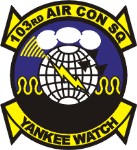 |
Air Control Squadron
Located: 1962 Orange, Connecticut
Redesignated: 16 June, 1992
Control & Reporting Center1
Deployments: Allied Force; Noble Eagle; Operation Enduring Freedom, Kandahar, Afghanistan
Manning: 48 full-time and over 200 guardsmen and women.
Equipment: TPS-75
Commander: Maj. Joseph D. Hammer, September 2004
Awards: 1994, Air Force Outstanding Unit Award
Deployments: Allied Force; Noble Eagle; Operation Enduring Freedom, Kandahar, Afghanistan
Notes: 1Command,
Control, Communications, Computer, and Intelligence (C4I) element within a mobile Theater Air Control System.
Letter of Redesignation and Realignment
|
104th (Air National Guard) |
  |
Aircraft Control & Warning Squadron Type F
Maine ANG
Constituted and allotted to the National Guard: effective 21 March 1949.
Authorized to organize: 30 August 1950 at Fort Preble, Portland, Maine
Federal recognition: 31 October 1950
Subordinate to: 151st AC&WG (1 November 1950)
Located: 1951, Port Preble, Maine
Activated: 1 September 1951 - 1 September, 1953
Relocated: 25 September 1951, Camp Edwards, Falmouth, Massachusetts
Subordinate to: 151st Tactical Control Group.
Reorganized and redesignated: 104th Tactical Control Squadron 8 February 1952
|
| |
Tactical Control Squadron
Reorganized and redesignated: 104th AC&WS, 16 June 1952
|
| |
Aircraft Control & Warning Squadron
Reorganized: 16 October 1952
Alerted for Foreign Service: 10 March 1953, but not mobilized
Relieved from active service: 1 September 1953
Notes: Returned, less personnel and equipment, to the control of the State of Maine.
|
| |
Tactical Control Flight
Forward Air Control Post
Constituted and allotted to the Oregon Air National Guard: 19 June 1971
Kingsley Air Force Station, Klamath Falls, Oregon
Subordinate to: 153rd Tactical Control Group.
Redesignated: 104th Tactical Control Flight (Forward Air Control Post - Heavy) 1 April 1976
Reassigned to: 154th Tactical Control Group
Relocated: North Bend Air National Guard Station, North Bend, Oregon, 1 June 1981
Relocated: Coos Head Air National Guard Station Coos Head, Oregon, 21 March 1988
Redesignated: 104th Tactical Control Squadron 15 October 1988.
|
| |
Tactical Control Squadron
Kingsley Field, Klamath Falls, Oregon ANG
Activated: 19 June, 1971
Control & Reporting Post: 20 August, 1971
Manning: 27 Officer, 213 Airmen
Equipment MPS-11, TPS-40
Inactivated: 31 March 1976
|
|
Tactical Control Flight
Kingsley Field, Klamath Falls, Oregon
Activated: 19 June, 1971
Forward Air Control Post: 20 August, 1971
Manning: 5 Officer, 43 Airmen
Activated: 19 June, 1971
Relocated: North Bend Air National Guard Station
June, 1981
Deployed: Pedro Dome, Alaska, Brim Frost January 1983
Relocated: Coos Head Air National Guard Station Coos Head, Oregon,
March, 1988
Manning: 5 Officers, 36 Airmen
Subordinate to: 154th TCG
Deactivated: 15 October, 1988
Redesignated: 104th Air Control Squadron on 16 June 1992
Equipment: TPS-44, TPS-43E
Photos:
Brim Frost '83, Pedro Dome, Alaska
|
|
Tactical Control Squadron - OLAA
Kingsley Field, Klamath Falls, Oregon |
| |
Air Control Squadron
Redesignated: 16 June, 1992
Deactivated: 30 September 1996
Equipment: TPS-75
History: Letter of Activation; Letter of Redesignation and Realignment; Unit History
|
105th (Air National Guard) |
 
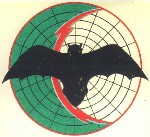
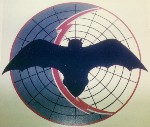
|
Aircraft Control & Warning Squadron
New Jersey ANG
Federalized: 1 September 1951 – 1 August, 1953 at
Grenier AFB, New Hampshire
Deployment: Earnest Harmon AFB, Newfoundland
|
| |
Radar Calibration Detachment
Activated: 1 November 1951
Located: Donaldson Air Force Base, Greenvelle, South Carolina
|
|
Tactical Control Squadron
Four Lakes, Washington ANG
Control & Reporting Post: 20 August, 1971
Manning: 27 Officer, 213 Airmen
Created: 19 June, 1971
Deployments: NATO W Germany 1989; Bahamas Drug Interdiction 1989
Equipment: MPS-11, TPS-40, TPS-43E
|
| |
Tactical Control Flight
Four Lakes, Washington
Forward Air Control Post: 20 August, 1971
Manning: 5 Officer, 43 Airmen
Created: 19 June, 1971
|
| |
Air Control Squadron
Four Lakes, Washington
Redesignated: 16 June, 1992 as Air Control Squadron
Mission: To man, equip and train mobile Tactical Radar Control and Warning Post personnel.
Deployed: 1994, Sagres, Portugal
Commanders:
1994, Lt. Colonel John T. Wittman
Exercises:
1994
Steady State
Central Enterprise
Keen Edge
Eagle Strike
Letter of Redesignation and Realignment
|
106th (Air National Guard) |
 

|
Air Control Squadron
Allotted: 24 May 1946 to ANG |
| |
Aircraft Control & Warning Group
White Plains, New York ANG
Federalized: 1 September 1951 as 152nd AC&WG at
Grenier AFB, New Hampshire
Reorganized and Redesignated: AC&WS November 1951
|
| |
Aircraft Control & Warning Squadron
Mobilized: 1 August, 1951 – 1 August, 1953
1 September 1951 – October, 1951
Deployment: St. Johns, Newfoundland;
Departed 31 March, 1952, on the USNS General Stuart Heintzelman
Arrived 6 April, 1952
Commander: Major Gironda
Roslyn, New York
Sioux City, Iowa
|
| |
Radar Calibration Detachment
O’Hare Airport, Chicago, Illinois
Grenier Air Force Base in New Hampshire
11 September, 1951
Redesignated: October 1951 the 106th Radar Calibration Squadron
Departed: Grenier AFB 31 March, 1952
Municipal Airport, Sioux City, Iowa.
April, 1952
Deactivated: 31 August, 1953
Subordinate to: 156th AC&W Group
|
| |
Tactical Control Flight
Roslyn, New York
Deployment: Mannheim, Germany
1 October, 1961 – 15 June 1962
|
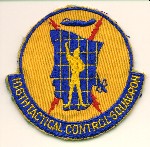 |
Tactical Control Squadron
Salt Lake City, Utah
Control & Reporting Post: 20 August, 1971
Manning: 27 Officer, 213 Airmen
Created: 19 June, 1971
Equipment: MPS-11, TPS-43 Basic; TPS-43E |
|
Tactical Control Flight
Salt Lake City, Utah
Forward Air Control Post: 20 August, 1971
Manning: 5 Officer, 43 Airmen
Redesignated: 109th TCF
19 June, 1971 – 15 October, 1988 (redesignated ACS)
Equipment: MPS-11, TPS-43 Basic; TPS-43E |
| |
Air Control Squadron
Grenier AFB, New Hampshire
1 September, 1951 – November, 1951
Salt Lake City, Utah
Redesignated: 15 October, 1988
Deactivated: 30 September, 1995
Equipment: TPS-43E; TPS-75 (August 1993)
Letter of Redesignation and Realignment
Refer to History Timeline of 106th and 109th
Photos:
106th/109th
|
107th (Air National Guard) |
|
Aircraft Control & Warning Squadron
Arizona ANG
Allotted: 24 May 1946 to ANG
Federalized: 1 September 1951 as 152nd AC&WG at
Otis AFB, Massachusetts
Mobilized: 9 July, 1951 – 1 August, 1953
Deployments: Goose Bay Airport, Labrador
|
| |
Radar Calibration Detachment/Flight
Activated: 1 November 1951
Located: 1951, Alexandria Municipal Airport, Alexandria, Louisiana
Exercises: 1952, Long Horn Calibration - to determine capabilities of Ground Radar Sites near Brady and San Saba, Texas of the 157th Aircraft Control and Warning Group and to furnish complete chart reports.
|
| |
Tactical Control Squadron
Phoenix, Arizona
Activated: 10 June 1972 – (?)
Commander: LTC Howard Barikmo
Call sign: Autumn Control
|
| |
Tactical Control Flight
Phoenix, Arizona
Activated: 10 June 1972 - (?)
Commander: Major Lee Dixon
Equipment: Never received any as programmed equipment was used as a test bed at McClellan AFB.
|
| |
Air Control Squadron
ACS – 16 June, 1992 – Present
Papago Park, Phoenix, Arizona
Luke AFB, Arizona - December 2008
Control & Reporting Center
Mission: 1999, Trains weapons directors for the Combat Air Forces
Letter of Redesignation and Realignment
|
108th (Air National Guard) |
|
Radar Calibration Detachment
Federal Recognization: 29 June 1948 at
Ellington AFB, Texas
Mobilized: October 1951
Relocated: Hamilton AFB, California
Redesignated: 108th RCF (Radar Calibration Flight) 1 March 1952
Released from federal service: 1 February 1953
|
|
Aircraft Control & Warning Squadron
New York
ANG
Allotted: 24 May 1946 to ANG
Federalized: 1 September 1951 as 152nd AC&WG at
Grenier AFB, New Hampshire
Hancock Airport, New York
AC&WS: 1 September, 1951 – 5 February, 1952
Mobilized: 1 August, 1951 – 1 August, 1953
Deployments: St. John's, Newfoundland by Pepperrell AFB, Newfoundland
Redesignated: 642nd AC&WS
|
|
Aircraft Control & Warning Flight
1 October, 1961 – 15 June, 1962
|
|
Tactical Control Flight
19 June, 1971 – 15 October, 1988
|
|
Tactical Control Squadron
Syracuse, New York
Control & Reporting Center: 20 August, 1971
Manning: 29 Officers 237 Airmen
|
| |
Air Control Squadron
16 June, 1992 – (?)
Letter of Redesignation and Realignment
|
109th (Air National Guard) |

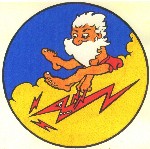
|
Aircraft Control & Warning Squadron
1954 – (?) |
| |
Tactical Control Flight
Utah
ANG
Activated: 1 April 1976 – 15 October, 1988
Equipment: MPS-11; TPS-43 Basic; TPS-43E
|
| |
Tactical Control Squadron
Activated: 15 October, 1988 – 16 June, 1992
Redesignated: ACS 16 June 1992
Equipment: TPS-43E; TPS-75 (April 1992)
|
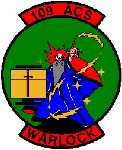 |
Air Control Squadron
16 June, 1992 – Present
Equipment: TPS-43E; TPS-75 (April 1992)
Notes: Refer to History of 106th and 109th
Photos:
106th/109th
|
110th (Air National Guard) |
  |
Aircraft Control & Warning Squadron
Created: 1951, Congaree Air Base, Eastover, South Carolina ANG
Activated: October 1951
Relocated: Donaldson AFB, Greenville, South Carolina
Subordinate to: 155th Tactical Air Control Group, Columbus, Ohio
Mobilized: 1 November, 1951 – 1 November, 1953 - Bitburg Air Base, Germany
Redesignated: 114th Aircraft Control and Warning Squadron
|
 131X150.jpg) |
Tactical Control Flight
Alcoa, Tennessee ANG
Forward Air Control Post: 20 August, 1971
Manning: 5 officers, 43 Airmen
June, 1971 – 15 October; 1988 – 16 June, 1992 |
| |
Tactical Control Squadron
15 October, 1988
|
| |
Air Control Squadron
Redesignated: ACS – 16 June, 1992 – (?)
Letter of Redesignation and Realignment
|
111th (Air National Guard) |
 

|
Air Control Squadron
Allotted: 24 May 1946 to ANG |
| |
Aircraft Control & Warning Squadron
Pennsylvania ANG
Federalized: 15 January 1952 at
Grenier AFB, New Hampshire
16 January, 1952 – 1 December, 1953
Mobilized: 1 December, 1951
Demobilized: 1 December 1953, Returned to Pennsylvania control
|
| |
Tactical Air Control Party/Flight
Brunswick, Georgia ANG
April, 1989 – (?)
|
| |
Tactical Control Flight
Alcoa, Tennessee ANG
Forward Air Control Post: 20 August, 1971
Manning: 5 Officer, 43 Airmen
|
| |
Tactical Control Flight (Air Support Radar Team)
9 October, 1981 – (?)
Letter of Redesignation and Realignment
|
112th (Air National Guard) |
| |
Radar Calibration Detachment
Allotted: 24 May 1946 to Air National Guard
Constituted: 24 May 1946 as 112th Radar Calibration Detachment, Van Nuys Airport, California
Deployed: August 1948, McChord Washington for training.
Redesignated: 16 August 1951, 112th Radar Calibration Flight
Redesignated: 5 September 1952, 112th Radar Calibration Squadron
Redesignated: 1 February 1953, 112th Radar Calibration Flight
|
 |
Aircraft Control & Warning Squadron
Pennsylvania ANG
Allotted: 24 May 1946 to ANG
Created: 1 April 1949, General Order Number 23
Federal Recognition: 2 May 1949
Reorganized: October 1949, 2 GCI stations; State College and Mifflin County Airport
Activated: December 1951
Deployed: 16 January 1952 to
Grenier AFB, New Hampshire
Mobilized: 1 December, 1951 – 1 December, 1953
Demobilized: 1 December 1953, returned to Pennsylvania control
Equipment: SP-1M September 1949
Commanders:
1 April 1949 - August 1950 Lt. Colonel Walter N. Brown
August 1950 - March 1952 Major John E. McHugh
March 1952 - 1963 Lt. Colonel Kenneth L. Royer
|
| |
Aircraft Control & Warning Flight
Reconstituted: 30 November 1953
Assigned: to 157th TCG Missouri ANG
Reassigned: May 1958 to 152 TCG New York ANG
Activated: 24 August 1961 for Berlin Crisis
Deployed: ADVON deploys 1 October 1961 Germany; 8 - 12 November 1961 the rest of the unit activated and deployed to Fliegerhorst Buechel, Germany
Operational: 28 January 1962 at Fliegerhorst Buechel, Germany
Redeployment: Received orders 9 May 1962; 13 June 1962 equipment left on convoy for port of Bremerhaven, Germany; 4 July 1962 ADVON arrives Brooklyn Army Terminal to collect unit equipment; 12 - 25 July 1962 personnel start to arrive to out process
Awards: PANG Frank A. Weber Trophy
Equipment: AN/MPS-11 (1957), AN/MPS-16 (1958)
Note: Unit's radar is sent to Southeast Asia and replace by a simulator
Commanders:
1952 - January 1963 Lt. Colonel Kenneth L. Royer
January 1963 - 2 October 1968 Lt. Colonel John R. Fisher
Exercises:
Exercise Swift Strike 3, May 1963
Exercise Desert Strike July-August 1964
Detachment: Mifflin County Airport closed April 1954
|
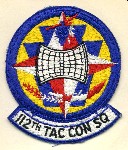 |
Tactical Control Squadron
State College, Pennsylvania
Redesignated: 15 October 1988 as TCS
Control & Reporting Post
Manning: 27 Officer, 213 Airmen
Commanders:
1979 - 1994 Lt. Colonel James M. Herron
Deployment: July 1989 Great Exuma, Bahama Island for counter-drug operations
Exercises:
June 1989 Exercise Sentry Yankee ’89
August 1989Exercise Sentry Independence ’89
Sep/Oct 1989 Exercise Display Determination ‘89, Canakkale, Turkey
June 1990 Exercise Sentry Yankee ’90, Sea Girt, New Jersey
June 1990 Exercise Sentry Independence 90, Volk Field, Wisconsin
July 1990 Operation Commodore, Erie Pennsylvania
September 1990 Operation ANGIE, Great Inagua, Bahamas Islands
May/June 1991 Exercise Ocean Safari, Ovar, Portugal
September 1991 Operation ANGIE, Great Inagua, Bahamas Islands
February 1992 Operation ANGIE, Great Inagua, Bahamas Islands
Awards:
USAF Outstanding Unit Award
|
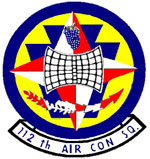 |
Air Operations Squadron
Redesignated: 1 October 2003, conversion begins and unit name is changed
Commanders:
January 1994 - January 2000 Lt. Colonel Walter D. Douthitt
January 2000 - 9 May 2004 Lt. Colonel Theodore Sebastianelli
9 May 2004 - 2008 Colonel Joel F. Pannebaker (Promoted Colonel 10 September 2006)
2008 - 20XX Colonel Keith (NMI) Locklear
Exercises:
June 2004 15 personnel for Coalition/Joint Task Force Exercise 04-2, Shaw AFB, South Carolina
January 2005 19 personnel deploy for Exercise Blue Flag 05-1, Barksdale AFB, Louisiana
July 2005 19 personnel deploy for Exercise Blue Flag 05-2, Nellis AFB, Nevada
January/February 2006 13 personnel deploy for Exercise Virtual Flag 06-2, Nellis AFB, Nevada
May/October2006 3 personnel deploy to support Operation Iraqi Freedom, Nellis AFB, Nevada
May/August 2006 2 personnel deploy in support of Operation Jump Start, Andrews AFB, MD
August 2006 17 personnel deploy for Red Flag 06-2.1, Nellis AFB, Nevada
4 September 2006 4 personnel deploy for AEF 3/4, Al Udeid AB, Qatar
November/December 2006 6 personnel deploy for Exercise Terminal Fury, Hickam AFB, Hawaii
January 2007 2 personnel deploy for Exercise Red Flag 07-2.1, Nellis AFB, Nevada
January 2007, 11 personnel deploy for Exercise Red Flag 07-2.1, Nellis AFB, Nevada
January 2007 5 personnel deployed for AEF, JADOC, Andrews AFB, MD
January 2007, 112th AOS hosts first AOC exercise, Exercise Cyclone Thrust
April/May 2007, 8 personnel deployed Exercise Blue Flag 07-2, Davis-Montham AFB, Arizona
June 2007, 20 personnel deployed Exercise Blue Flag 07-2, Davis Montham AFB, Arizona
July 2007, 14 personnel deployed for Exercise Virtual Flag 07-4
September 2007, 19 personnel for Operation Northern Sovereignty, Elmendorf AFB, Alaska (First deployment of 112th AOS)
October 2007, Exercise Eagle Talon/Unified Endeavor
January 2008, 18 personnel deployed for Exercise Red Flag 08-2.1, Nellis AFB, Arizona
March 2008, Exercise Arctic Keystone
April/May 2008, 2 personnel deploy for exercise Austere Challenge, Ramstein AB, Germany
Links:
Chief Master Sergeants
Commanding Officers
Roster
|
|
|
|
|